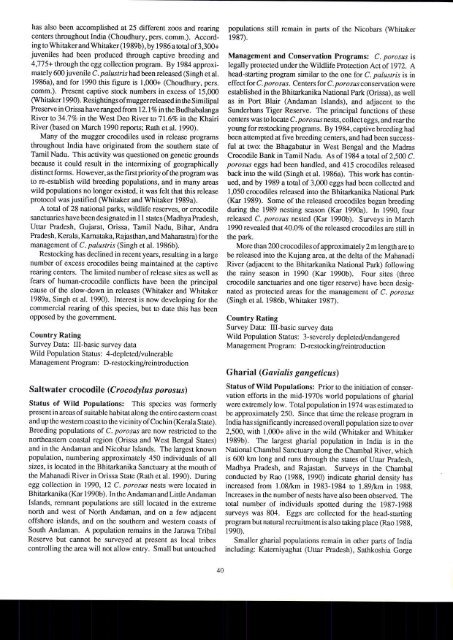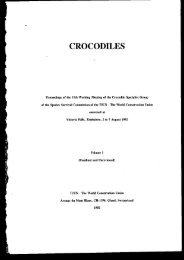size: 7451KB - Crocodile Specialist Group
size: 7451KB - Crocodile Specialist Group
size: 7451KB - Crocodile Specialist Group
You also want an ePaper? Increase the reach of your titles
YUMPU automatically turns print PDFs into web optimized ePapers that Google loves.
has also been accomplished at 25 differenl zoos and re3ring populaiions still remain in pans of tho Nicobars (Whitrker<br />
ccnters throughout India (Choudhury, pers. comm.). Acrording<br />
to Whialer and Whitaker ( 1989b), by 1986 a toral of33m+<br />
1987).<br />
juvedlos had been poduced thrcugh captive breeding and Management and Conserration Programs: C. porosus is<br />
4,775+ through the egg collecrion program. By 1984 approximately<br />
600 juvenile C. palBrlir had be€n releas€d (Singh er al. head-staning progmm similar to the one for C. pall/Jfir is in<br />
legally prote.red under the Wildlife Protc.tion Act of 1972. A<br />
1986a), and for 1990 this figure is 1,000+ (Choudhury, pers. etlectfor C. porosus. Centgrs for C prlrflr conservation were<br />
comm.). Present captive stock numbers in excess of 15,0m established in the Bhitarkanita National Pa* (Orissa), as well<br />
(Whitaker 190). Resightingsof muggerrclea.scd in the Similipal as in Port Blair (An&man Islands), and adjaceni !o rhe<br />
Preservc in Orissa haveranged from 12. 1% in tho Budhabalanga Sunderbans Tiger Reserve. Thc princip3l functions of these<br />
River lo 34.7% in the West Deo River lo 71.6% in lhc Khairi cenlef was 10 locaae C. pr,'ostJ nests, collect eggs, and rcar the<br />
River Oased on March 1990 rcports; Rath er al. 1990). young for restocking prog:ams. By 1984, caprive bre€ding had<br />
Many of the muggor crocodiles used in rctease programs been attempted at five breeding centers, and had been successful<br />
at tro: the Bhagabatur in Wesr Bengal and the Madms<br />
tlroughout India have originared from the sourhem sraie of<br />
Tamil Nadu. This activity was quesrioned on genctic grounds Crocodilc Bank in Tamil Nad'r. As of 1984 a toral of 2,5OC C.<br />
b€causo it could result in the inlcmixing of geographically poroxw eggs had b€en hdndled, and 415 crocodiles released<br />
distinct forms. However, as the fi^t priority ofrhe program was back into the wild (Singh er al. 1986a). This work har conrinued,<br />
and by 1989 a loral of 3,0m eggs had been collecr.d and<br />
to re-esrablish wild br€fding populalions, and in many areas<br />
wild populations no longo eristed, ir was fell thar this releas€ I,050 crocodiles rcleased into the Bhira*a ka National Park<br />
protocol was j ustified (Whitaker and Whitaker 1989a). (Kar 1989). Somo of the released crocodiles began breeding<br />
A total of 28 national parks, wildlife rc.serves. or crocodile during the 1989 nesting season (Kar 1990a). In 1990, four<br />
sanctuaries have been designaled in I I stat€s (Madhya hadesh, releascd C. pordrrls nesl,ed (Kar 1990b). Surveys in March<br />
Ulhr hadesh, Cujaral, Orissa, Tamil Nadu, Bihar, Andra 1990 revcaled that40.0% of tho rcleased crocodiles arc srill in<br />
Pmdosh, Kerala, Kamataka, Rajasthan, and Maharastra) for the the park.<br />
management of C. pdturrr1 (Singh et al. 1986b).<br />
Morc rhan 200 crocodiles ofapproximalely 2 m length aie r.r<br />
Restocking has decline.d in rccent years, resulting in a large be rolea-sed inlo the Kujang area, a! the delta of the Mahfiadi<br />
number of excess crccodiles being mainrained at thc caprive River (adjacent!o the Bhitarkanika Narional Park) following<br />
rqring centers. Thc limited number of rclcase sires as well as the rainy s€ason in 19m (Kar 1990b). Four sites (lhrcc<br />
f€ars of human-crocodilc conflicts havo bccn the DrinciDal crocodile sanctuarics ard one tiger rescrve) have been designarcd<br />
as protected areas for the management of C. pdro.rl1r<br />
caus€ ol the slow-down in rcleas€s (Whrraler and Whilal(er<br />
1989a, Singh ei al. 1990). Interest is now developing for the (Singh er al. 1986b, Whiraker 1987).<br />
commercial rearing of this species, bui !o datc rhis has been<br />
opposed by the govcmment.<br />
Country Rating<br />
Survey Data: Ill-basic survey alaln<br />
Wild Population Slatus: 4deplered/vulnerable<br />
ManagemenL Program. D resro(king,/reinuoduction<br />
Saf twater crocodif e (C rocodXlus porosus)<br />
Status of Witd Popnlationst This species was fomerly<br />
pres€nt in areas of suitable habila! along lhe emirc easlem coas!<br />
and up (hc vvestem coasto the vicinity ofcochin (Kerala Srare).<br />
Breeding populalions of C. polrrrr are now reslricled to rhe<br />
norlieastem coastal rcgion (Orissa and \ry'est Bengal Stalet<br />
and in fte Andaman and Nicobar Islands. The largcsr known<br />
population, numbering approximar,ely 450 individuab of aI<br />
<strong>size</strong>s, is located in the Bhitarkanika Sancruary at the mouih of<br />
the Mahanadi River in Orissa S |atc (R ath er al. 1990). During<br />
egg collection in 1990. 12 C. po.rrr.! nesrs were locarcd in<br />
Bhitarkanika (Kar 1990b). In rhe Andaman and LiuteAndaman<br />
Islands, iemnant populadons are still loca0ed in $e exrreme<br />
north and west of Nonh An&man, and on a few adjaccnr<br />
offshore islands, and on the soulhcm and westem coasB of<br />
Soud Andarnan. A population rcmains in rhe Jarawa Tribal<br />
Rcserve but cannot bc surveyed at present as local tribes<br />
controlling the area will not allow enlry. Small bur untouched<br />
40<br />
Country Rating<br />
Survey Dala: trI-basic survey dala<br />
Wild Populalion Status: 3-scvcrely depleled,/endangeEd<br />
Management Programi D-restockingteintroduclion<br />
Gharial (G aialis g on geticu s)<br />
Status of Wild Populations: Prior ro the initiadon of conservation<br />
efforts in the mid-1970s world populadons of gharial<br />
werc cxEemely low. Toral population in 19?4 was esumarcd !o<br />
bc app.oximarl) 250. Since rhal limc lhe release program m<br />
India has significandy incrcased overall populadon <strong>size</strong> [o over<br />
2,500, with 1,000+ alivc in fte wild (Whitrker alld Whitrker<br />
1989b). The largest gharial fJopularion in India is in the<br />
National Chambal Sanctuary along rhe Chambal River, which<br />
is 600 km Iong and.uns through rhe states of Uuar hadesh,<br />
Madhya Pnalesh, and Rajastan. Surveys in rhe Chambal<br />
cond&ted by Rao (1988, 1990) indic-ale gharial density has<br />
increased from l.08^m in 1983,1984 io 1.89^rn in 1988.<br />
Increases in the numt'er ofnests havc also b€en obscrved. The<br />
lo1al number of individuals spotled during rhe 198?-1988<br />
surveys was 8O4. Eggs are collecred for the hcad-srarting<br />
program but nalural recruitrnent is also raking placc (Rao 1988,<br />
1990).<br />
Smaller gharial popularions rcmain in olier paris of India<br />
inclMing: Katemiyaghat (Ullar Pradcsh), Salhkoshia corge

















